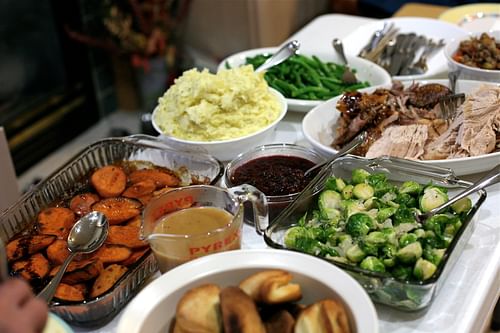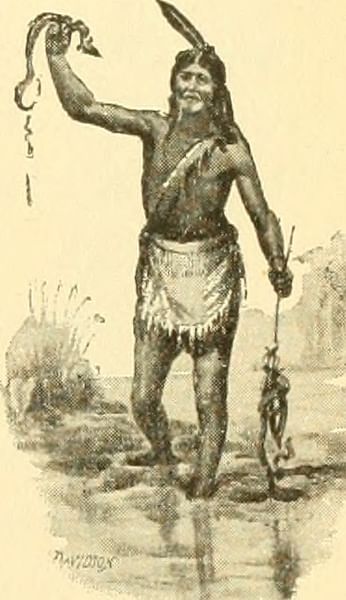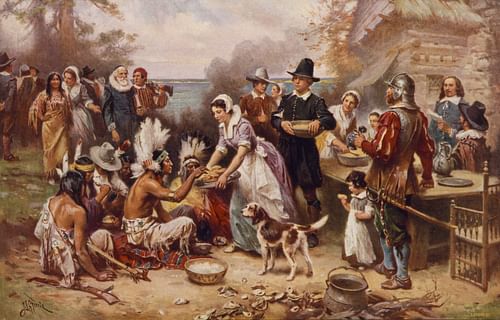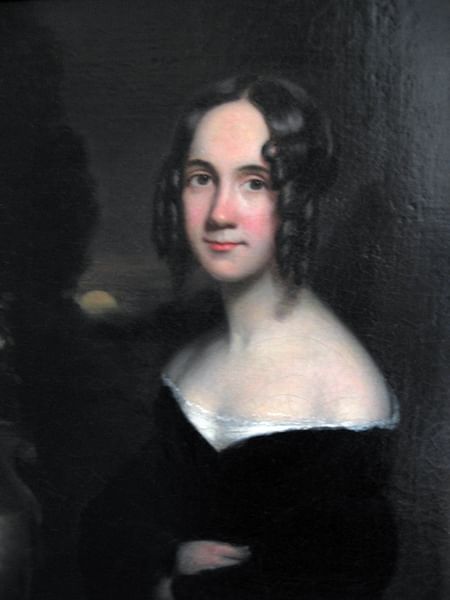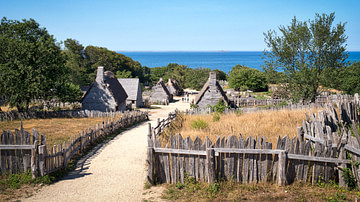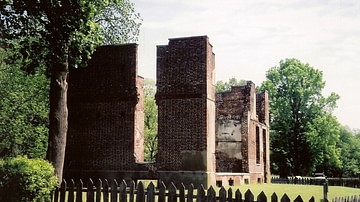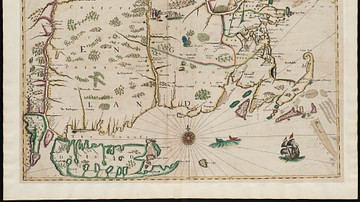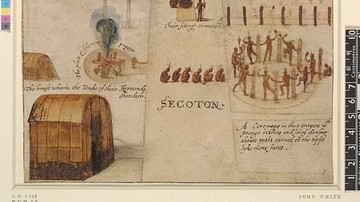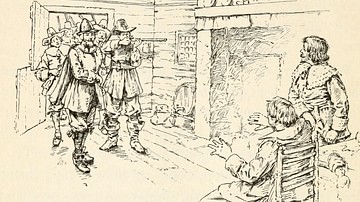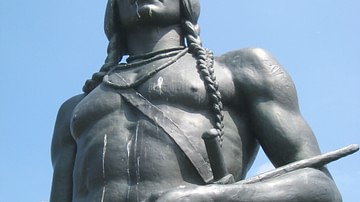The United States holiday of Thanksgiving is generally understood to be inspired by the harvest feast celebrated by the citizens of Plymouth Colony (later known as pilgrims) and the Native Americans of the Wampanoag Confederacy in the fall of 1621.
Although there is evidence of earlier thanksgiving celebrations in the Americas by the Spanish in the 16th century and at the Jamestown Colony of Virginia in 1610, following what is known as the “starving times” of 1609, these are not recognized as the “First Thanksgiving”, a term coined by the editor Alexander Young in 1841 referring specifically to the account of the 1621 event as given by the Plymouth Colony's chroniclers William Bradford (l. 1590-1657) and Edward Winslow (l. 1595-1655) in Mourt's Relation (published 1622), the earliest work on the first year of the establishment of Plymouth Colony.
Once the Plymouth Colony had successfully established itself, after struggling through their first year, Mourt's Relation was carried back to England and published by Robert Cushman (l. 1577-1625) who had negotiated the Mayflower voyage. The book seems to have been an initial success before going out of print and was only brought back to public notice in 1841. Bradford's work, Of Plymouth Plantation, which also references the 1621 event, was published in 1856 and the popular poem, The Courtship of Miles Standish by Henry Wadsworth Longfellow (l. 1807-1882) came out in 1858 all further popularizing the story of the pilgrims.
Sarah Josepha Hale (l. 1788-1879), the writer and editor of the popular periodical Godey's Lady's Book (published 1830-1878), campaigned for the national observance of Thanksgiving Day beginning in 1846. She wrote to each sitting president advocating the adoption of the holiday, but it was only acted upon in 1863 by President Abraham Lincoln (served 1861-1865) during the American Civil War (1861-1865) as a means of encouraging national unity.
It is thought, however, that his decision was influenced by the popularity of the pilgrims' story through the above publications in concert with Hale's advocacy. The modern celebration of the holiday was formalized across the United States only as recently as 1963 under President John F. Kennedy (served 1961-1963), although it had been observed regionally for 100 years prior.
Presently, it is one of the most popular celebrations in the United States most often observed by gatherings of friends, family, a large meal, and participating in or watching American football games; the pilgrims and their Native American guests serving mainly as backdrops and decorations for the event, but this version of the observance is fairly recent and often ignores the realities of the historical event which inspired it.
Plymouth Colony & First Thanksgiving
The Plymouth Colony was founded by a group comprised of Puritan separatists (the pilgrims) and Anglican settlers who had been hired or invited to join them by the merchant adventurer Thomas Weston (l. 1584 - c. 1647) who secured them a patent from the Virginia Company of London and rented them the Mayflower to establish a profitable colony in Virginia. The Mayflower was blown off course, however, and landed in New England, far from the already established colony of Jamestown, which they had thought they could count on for assistance.
Dropping anchor off the coast of Cape Cod on 11 November 1620, the 102 passengers of the Mayflower understood they were on their own, winter had already begun, they were short on supplies, and had arrived too late to plant any crops. They survived by stealing caches of corn from the Native Americans, raiding graves where food was left as offering, and hunting expeditions but, even so, between December of 1620 and March of 1621, 50% of the passengers and crew would die of malnutrition and various diseases.
They were saved in March 1621 when the Native American Samoset (also given as Somerset, l. c. 1590-1653) walked boldly into the settlement, welcomed them in English, and introduced them to Tisquantum (better known as Squanto, l. c. 1585-1622, who also spoke English) and the chief of the Wampanoag Confederacy Ousamequin (better known by his title, Massasoit, l. c. 1581-1661). Massasoit ordered Squanto to remain with the pilgrims and teach them how to survive.
By the fall of 1621, with Squanto's help, the colonists were able to bring in a good crop and had been shown the best hunting grounds and fishing streams. The colonists decided to celebrate with a harvest feast which has since been defined as the First Thanksgiving. The narrative of the event is usually given along the lines provided by the scholar George F. Willison in his 1945 book, Saints and Strangers: Being the Lives of the Pilgrim Fathers & Their Families, with Their Friends and Foes, which is loosely based on Bradford's and Winslow's earlier account:
As the day of the harvest festival approached, four men were sent out to shoot waterfowl, returning with enough to supply the company for a week. Massasoit was invited to attend and shortly arrived – with ninety ravenous braves! The strain on the larder was somewhat eased when some of these went out and bagged five deer. Captain Standish staged a military review, there were games of skill and chance, and for three days the Pilgrims and their guests gorged themselves on venison, roast duck, roast goose, clams and other shellfish, succulent eels, white bread, corn bread, leeks and watercress and other “sallet herbes”, with wild plums and dried berries as dessert – all washed down with wine, made of the wild grape, both white and red, which the Pilgrims praised as “very sweete and strong”. At this first Thanksgiving feast in New England, the company may have enjoyed, though there is no mention of it in the record, some of the long-legged “Turkies” whose speed of foot in the woods constantly amazed the Pilgrims. (189)
The story of the First Thanksgiving comes from only two sources initially: Bradford and Winslow's Mourt's Relation, which gives a detailed account, and Bradford's Of Plymouth Plantation, which references the event in more general terms. Bradford writes:
They began now [fall of 1621) to gather in the small harvest they had, and to prepare their houses for the winter, being well recovered and in health and strength and plentifully provisioned; for while some had been thus employed in affairs away from home, others were occupied in fishing for cod, bass, and other fish, of which they caught a good quantity, every family having their portion. All summer there was no want. And now, as winter approached, wild fowl began to arrive [and] they got abundance of wild turkeys besides venison. (Book II. ch. 2)
Harvest time had now come, and then instead of famine, God gave them plenty, and the face of things was changed, to the rejoicing of the hearts of many for which they blessed God. And the effect of their particular planting was well seen, for all had, one way or another, pretty well to bring the year about, and some of the abler sort and more industrious had to spare, and sell to others, in fact, no general want or famine has been amongst them since, to this day. (Book II. ch. 4)
Some versions of Bradford's work insert the line, “they set apart a day of thanksgiving” in place of, or after, “for which they blessed God” but this seems a later addition by an editor. The first version of the event, from Mourt's Relation, makes no mention of establishing a holiday for giving thanks:
Our harvest being gotten in, our governor sent four men on fowling, that so we might after a special manner rejoice together after we had gathered the fruit of our labors. They four in one day killed as much fowl as, with a little help beside, served the company almost a week. At which time, amongst other recreations, we exercised our arms, many of the Indians coming amongst us, and among the rest their greatest king, Massasoit, with some ninety men, whom for three days we entertained and feasted, and they went out and killed five deer, which they brought to the plantation and bestowed on our governor, and upon the captain [Myles Standish] and others. (82)
Bradford mentions turkeys, which most likely were served as part of the feast, but no menu such as provided by Willison appears in the primary documents and, although cranberries probably grew in the nearby wetlands, nothing suggests they were harvested. Further, since the settlement had no ovens, butter, or wheat for crusts, there were no pies, pumpkin or otherwise. The most glaring misrepresentation of the First Thanksgiving story, however, which routinely adheres to the above passage from Willison, is that the Native Americans of the Wampanoag were invited to the feast; neither of the primary documents suggests this in any way.
In March of 1621, the first governor of the colony, John Carver (l. 1584-1621) signed a peace treaty with Massasoit promising, among other stipulations, mutual aid in defense. Bradford and Winslow, in Mourt's Relation, mention the colonists firing their weapons (“we exercised our arms”) just before Massasoit and his warriors arrive and so it is more likely that they came in response to the sound of the muskets in accordance with the terms of the treaty.
Native American View
A second harvest festival is mentioned by Bradford (given above in Book II. ch. 4 from Of Plymouth Plantation) as taking place in 1623 but no mention is made of any other. Mourt's Relation, and another of Winslow's works, Good News from New England (published 1624), helped encourage the migration of more English to North America. Between 1630-1636, over 20,000 English colonists arrived in what has come to be known as the Great Migration. The treaty signed between Carver and Massasoit in 1621 was honored from 1621 until after Massasoit's death in 1661, but those drawn up between colonists and Native Americans afterwards were not. Native Americans were either driven from their lands or sold land to the colonists – willingly or not – and then moved further inland.
The rampant colonization of New England and continual land grabs finally resulted in the Pequot War of 1636-1638 when the Pequot tribe resisted colonization and the destruction of their heritage. The Pequots were defeated, many of them killed in battle or murdered afterwards, and survivors sold into slavery. The colonists of the Massachusetts Bay Company, not the Plymouth Colony, decreed a day of thanksgiving for their victory which is often interpreted by modern-day Native Americans as the basis for the Thanksgiving holiday which many observe as a Day of Mourning and reflection. Scholar Yvonne Wakim Dennis et al. sum up the Native American view:
National Thanksgiving Day observances are largely filled with myths and misinformation. Popular American folklore suggests the “first Thanksgiving” was an idyllic feast. This myth, which ignores the fact that the feast was never repeated and that Thanksgiving is an invented holiday, runs contrary to many realities. The tale ignores the Pilgrims, who plundered a Native person's store of corn for the winter and opened some graves; ignores the Wampanoag, who brought most of the food; ignores the Pilgrims who viewed the Wampanoag as heathens and savages; and ignores the Pilgrims who did not even call the three-day event “Thanksgiving”. Thanksgiving observances omit the fact that virtually all Native nations have ritual ceremonies of giving thanks to the Creator, ceremonies established long before the “Thanksgiving” in 1621 took place. (58)
New England colonists of the time, and later immigrant writers, had little interest in Native American culture or in narratives which challenged their own and so the details from Bradford's and Winslow's account were modified and Native American views ignored. The colonists of the 17th century declared many days of thanksgiving before and after attacks on Native American villages, especially during King Philip's War (1675-1678), and this is often cited in the present day by Native American tribes as a reason to observe Thanksgiving through mourning rather than celebration. Prior to the 19th century, the descendants of the early colonists themselves seem to have observed the holiday in various forms as well.
Development & Modern Celebration
Mourt's Relation and Of Plymouth Plantation only became available to the general public in 1841 and 1856, respectively, and so played no part in the First National Proclamation of Thanksgiving in 1777 which had nothing to do with the 1621 event and was intended as a solemn day of worship and praise of God. It was set for Thursday, the 18th of December 1777 and followed the model of the Puritan Day of Humiliation in which people would fast, pray for forgiveness of sins, and abstain from labor and recreation. This Thanksgiving observance would be unrecognizable to most Americans celebrating the holiday in the present era.
The popularity of the pilgrim narrative, as given by Bradford and Winslow and then developed by Longfellow and others, had developed a significant hold on the collective American imagination by the mid-19th century, which is why Sarah Josepha Hale's suggestion to President Lincoln was taken more seriously than her previous attempts to have Thanksgiving recognized nationally.
Hale was one of the most popular writers of her day, also responsible for advocating abolition, women's rights, elevating the status of cats from utilitarian pest control to pampered pets, and encouraging the tradition of trimming a tree as central to the celebration of Christmas. It seems clear that a woman of her fame and influence would have succeeded earlier in her advocacy for Thanksgiving if the presidents she wrote to had been more receptive to her claims; this was only possible, however, after the American public had embraced the story of the pilgrims and the 1621 event as a foundational myth.
Even after Lincoln's 1863 proclamation designating the 4th Thursday of November a national holiday, Thanksgiving was not celebrated in every state of the Union, certainly not in southern states, and though it was widely observed, the holiday received little blanket support from the U.S. government until the administration of John F. Kennedy in 1963 during a period of social unrest and conflict, similar in some respects to Lincoln's time. Like Lincoln's decree, Kennedy's proclamation was an effort at encouraging unity and mutual understanding among Americans.
Conclusion
Although the 1621 event is cited as the inspiration for the Thanksgiving holiday in the modern era, thanksgiving celebrations, up through and including Kennedy's proclamation, have been encouraged and observed in the United States for reasons having little to do with the accounts in the primary documents. In the 17th century, thanksgiving days were decreed to give thanks to God either in advance of or after a military action against Native Americans, in the 18th century, it was decreed by Congress for the same reason, only now in hopes of victory over the British, in the 19th century, it was an attempt to encourage unity during a time of civil war, and in the 20th, it sought to serve the same purpose.
To the Native Americans, however, who had their land, language, and culture systematically taken from them, Thanksgiving has nothing to do with unity and is understood as celebrating the English conquest and outright theft of lands they had occupied for thousands of years. Native Americans in the present day, whether through public displays or private rituals, observe the day quite differently from the descendants of the immigrants who arrived in North America in the 17th century.
For many Americans, the holiday is now defined by a large feast among family and friends and some form of participation in sporting events. To others, or the same, Thanksgiving in the present is little more than the starting gun of the holiday shopping season, and the pilgrims and Native Americans of the First Thanksgiving serve only as decoration around the table and in shop windows.
In 1621, however, no matter the motivation for succeeding observances, for three days the English colonists and their Native American neighbors – who did not even share the same language – are reported to have enjoyed each other's company over food and drink. Even if later incarnations of the holiday draw on invented aspects of the event, and no matter how cynical the observance may seem to many in the present, that initial event and the promise it symbolized is still worth celebrating as something to aspire to: as a time of genuine communion between people of different cultures, values, and goals, who, for a very brief period, and before it was betrayed, found a way to live together in peace.
